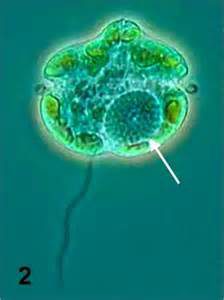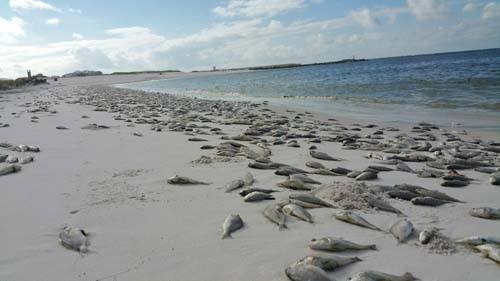At the time of this writing, red tide is still lingering off the Pensacola coast. By the time this is posted it may or may not be. I have had a few questions about red tide while this has been occurring here, and some misconceptions about it – so, now is a good time to try and set the story straight.

Red tide is actually caused by a group of small, single-celled marine plants. The one responsible for the red tide in the Gulf of Mexico is called Karenia brevis. Karenia is a naturally occurring dinoflagellate. If I were to pull a water sample off of Pensacola Beach right now I would find it there – albeit in small concentrations – say 300-500 cells in a liter of water. At these concentrations there are no problems. When we say problems, we mean respiratory problems or fish kills. See, Karenia is a dinoflagellate that when irritated or disturbed, will release a toxin – brevotoxin. This toxin is a neurotoxin that is known to kill fish, sea turtles, and marine mammals at high concentrations – greater than 1,000,000 cells / liter. For humans the issue is more of respiratory and eye irritation. Though consuming filter feeding shellfish, such as oysters and scallops, during a red tide can cause serious gastrointestinal problems and possibly hospitalization in humans. This is why the state closes shellfish harvesting when Karenia concentrations reach 5,000 cells / liter.
What causes Karenia concentrations to increase from 500 cells to 5,000 cells, or even 1,000,000 cells / liter?
The same thing that causes all plants to grow – sunlight and nutrients.
Here is where the first misconception arises.
“Red tides are caused by the increase of nutrients in the ocean due to human activity”.
Not exactly correct. Red tides have occurred in the Gulf of Mexico since the colonial period, and the colonists certainly did not discharge enough nutrients to spawn a red tide bloom. No, these blooms occur naturally. Most form off the coast of southwest Florida. There the continental shelf extends about 200 miles offshore before reaching the slope to the deep sea. At this slope there are upwelling currents bringing nutrients from the seafloor to bath these phytoplankton in the warm Florida sun. This combination, along with some other water chemistry needs, fuel the growth of phytoplankton from a few hundred cells / liter to a few thousand, hundred thousand, or even a million cells / liter – an algal bloom. At concentrations of 1,000,000 cells or more the water actually changes color to reddish – hence the name “red tide”.
However…
Today humans ARE discharging large amounts of organic and inorganic nutrients into local waterways. These eventually make their way to the Gulf and can enhance a natural bloom from say 10,000 cells / liter to over 1,000,000 – we can make the situation worse. This typically happens when offshore winds blow the naturally occurring red tides closer to shore to meet our “cocktail of nutrients” and wa-la – an enhanced bloom with enhanced problems.

Photo: Randy Robinson
Here in the northern Gulf the conditions to spawn naturally occurring red tides do not typically exist. What we usually see are the blooms generated in southwest Florida pushed northward but weather patterns. At the time of this writing, Escambia County is experiencing a red tide offshore at background/very low concentrations (0-10,000 cells/liter). Though are no reports of fish kills or respiratory issues in humans, but these are happening to our east in Okaloosa, Walton, Bay, and Franklin counties.
The state is aware of the not only the red tide situation, but other harmful algal blooms occurring around the state and has a task force to try and address these. We, of course, can help by reducing the amount of nutrients (fertilizers) we discharge into our local waterways. This would include not only commercial fertilizers, but any plant and animal waste.
References
Red Tide Current Status. 2021. Florida Fish and Wildlife Conservation Commission. https://myfwc.com/research/redtide/statewide/?utm_content=&utm_medium=email&utm_name=&utm_source=govdelivery&utm_term=campaign.
 0
0
